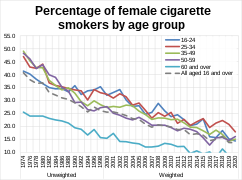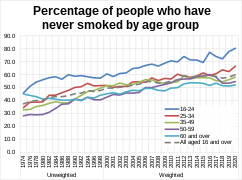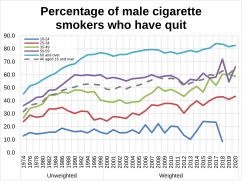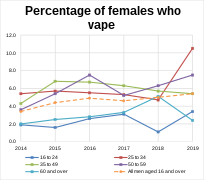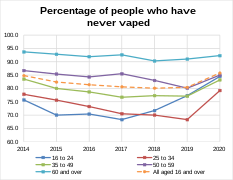Smoking in the United Kingdom
In the United Kingdom, smoking is legally permitted, with certain conditions set from laws enacted separately in England, Wales, Scotland and Northern Ireland. It is illegal to smoke tobacco in enclosed public places, such as restaurants, shops or pubs, under the Health Act 2006 for England and Wales, the Smoking (Northern Ireland) Order 2006 for Northern Ireland and the Smoking, Health and Social Care (Scotland) Act 2005 for Scotland. It is also illegal to smoke in a car if one is transporting people under 18 or if a vehicle is being used for work purposes. Smoking is prevalent among a sizeable, but continuously reducing minority of the population. It has been argued that smoking puts considerable strain upon the NHS due to the health problems which can be directly linked with smoking. Successive UK Governments have endeavoured to reduce the prevalence of smoking. As part of this commitment, the NHS currently offers free help to smokers who want to quit.
Prevalence
In 1962, over 70% of British men and 40% of British women smoked.[1] As recently as 1974, 45% of the British population smoked. This was down to 30% by the early 1990s, 21% by 2010, and 19.3% by 2013, the lowest level recorded for eighty years.[2] An annual No Smoking Day has occurred in March since 1984.[3]
In 2015, it was reported smoking rates in England had fallen to just 16.9%, a record low.[4] In 2018, the UK smoking rate had fallen to 14.4%.[5] 25–34 year olds had the highest smoking rate, with approximately 1 in 5 people within this age range (around 1.4 million adults) being smokers.
In 2019, one in five Scottish people — 850,000 adults — identified as smokers. Approximately 28% of men and 25% of women in Scotland smoked regularly in 2018, a rate higher than that of the United Kingdom as a whole.Template:Fix/category[citation needed]
Smoking prevalence varies with geography. In self-reported Annual Population Survey data, the local authorities of Kingston upon Hull and Blackpool had consistently high smoking prevalence rates of 22.2% and 23.4% respectively in 2019, while Ribble Valley and Rushcliffe had rates of 5.1% and 5.9%.[6] It is estimated that in some of the most deprived communities in Scotland, smoking rates may be as high as 47%. An estimated 40% of adults smoke in the constituency of Glasgow East, one of the most deprived seats in the entire United Kingdom. Template:Fix/category[citation needed]
- Smoking graphs
Health issues
It has been estimated by Cancer Research UK that smoking is the single greatest cause of preventable illness and early death, with around 107,000 people dying in 2007 from smoking-related diseases, including cancers, in the UK. Around 86% of lung cancer deaths in the UK are caused by tobacco smoking; overall tobacco smoking is estimated to be responsible for more than a quarter of cancer deaths in the UK, around 43,000 deaths in 2007.[7]
The British Medical Journal states that due to the drive to help smokers quit smoking, Britain has the world's largest reduction in the number of deaths from lung cancer. In 1950, the UK had one of the highest rates in the world. The annual number of deaths from lung cancer in 2000 was half of what it was in 1965.[8]
Reducing the prevalence of smoking to 5% could avoid nearly 100,000 new cases of smoking-related disease including 35,900 cancers over twenty years and save £67,000,000 a year in health- and social-care costs, according to research commissioned by Cancer Research UK.[9]
Age restrictions
England and Wales
From 1908 until 2007, the minimum age to purchase and consume tobacco products in public was 16 years of age. From 1 October 2007, the Children and Young Persons (Sale of Tobacco etc.) Order 2007 became effective, raising the minimum purchase age to 18 years of age.
Scotland
Until 30 September 2007, the minimum age to purchase and consume tobacco products in public was 16 years of age. From 30 September 2007, the Tobacco and Primary Medical Services (Scotland) Act 2010 became effective, raising the minimum purchase, consumption, and possession age to 18 years of age.
Section 4: Sale of tobacco products to persons under 18
(1) A person who sells a tobacco product or cigarette papers to a person under the age of 18 commits an offence.Section 5: Purchase of tobacco products by persons under 18
(1) A person under the age of 18 who buys or attempts to buy a tobacco product or cigarette papers commits an offence.
Section 6: Purchase of tobacco products on behalf of persons under 18
(1) A person aged 18 or over who knowingly buys or attempts to buy a tobacco product or cigarette papers on behalf of a person under the age of 18 commits an offence.
— Tobacco and Primary Medical Services (Scotland) Act 2010, Chapter 1 – Sale and purchase of tobacco products
Section 7: Confiscation of tobacco products from persons under 18
(1) Where a constable has reasonable grounds for suspecting that a person in a public place—
- (a) is under the age of 18, and
- (b) is in possession of a tobacco product or cigarette papers,
the constable may require the person to surrender the tobacco product or, as the case may be, the cigarette papers to the constable.
(7) The constable may dispose of any tobacco product or cigarette papers surrendered to the constable in such manner as the constable considers appropriate. (8) In this section "public place" includes—
- (a) any place to which the public have access for the time being (whether on payment of a fee or otherwise), and
- (b) any place to which the public doesn't have access but to which the person mentioned in subsection (1) has unlawfully gained access.
— Tobacco and Primary Medical Services (Scotland) Act 2010, Chapter 1 – Miscellaneous
Northern Ireland
Until 31 August 2008, the minimum age to purchase and consume tobacco products in public was 16 years of age. From 1 September 2008 the Children and Young Persons (Sale of Tobacco etc.) Regulations (Northern Ireland) 2008 became effective, raising the minimum purchase, consumption and possession age to 18 years of age.
Section 3: Prohibition on sale of tobacco, etc. to persons apparently under 18
(1) Subject to paragraph (2), a person who sells to a person under the age of 18 any tobacco or cigarette papers, whether for his own use or not, shall be guilty of an offence.Section 5: Seizure of tobacco, etc. in possession of persons apparently under 18
(1) A member of the Police Service of Northern Ireland may seize any tobacco or cigarette papers in the possession of any person apparently under the age of 18 whom he finds smoking in any street or public place.
(2) Any tobacco or cigarette papers seized under paragraph (1) shall be disposed of in such a manner as the Police Authority for Northern Ireland may direct.
— Health and Personal Social Services (Northern Ireland) Order 1978, PART II – Sale of Tobacco, Etc. to Persons Apparently Under 18
Smoking bans
Smoking in workplaces and enclosed public spaces has been illegal since 26 March 2006 in Scotland, 2 April 2007 in Wales, 30 April 2007 in Northern Ireland and 1 July 2007 in England.[10][11]
On 1 October 2015, a law was passed which banned smoking in vehicles with anyone under eighteen years of age present. The law does not apply to e-cigarettes, if the driver is seventeen years of age and alone in the vehicle, or in a convertible with the roof completely down.[12]
Further restrictions
On 6 April 2012, the display of tobacco products was banned in retailers larger than 280 square metres in England. The ban affected small retailers three years later on 6 April 2015.[13] In Scotland, a ban on the display of tobacco products for large retailers entered into force in April 2013.[14] The ban for display for small retailers entered into force in April 2015.[15]
In March 2011, the Conservative-Liberal Democrat coalition government committed itself to holding a public consultation on the introduction of plain tobacco packaging. Influenced by the introduction of plain packaging in Australia, the House of Commons voted 367–113 in March 2015 to pass the Children and Families Act 2014, which gave the government the power to require plain packaging for tobacco products.[16] This came into force on 20 May 2016, but tobacco companies were given one year to sell off remaining stock, after which all tobacco products sold in the UK would have to follow plain packaging laws.[17]
Electronic cigarettes
Despite the name "e-cigarette," these devices contain no tobacco and produce no smoke. They are used as an alternative to smoking, or as devices where it increasingly looks like they are helping young people avoid smoking.[18] Two hospitals run by Sandwell and West Birmingham Hospitals NHS Trust opened vape shops in 2019 in conjunction with a ban on smoking. Public Health England advises hospitals to let patients vape indoors and in bed. [19]
On 2 April 2014, the Welsh Government published a public health white paper in which it proposed a ban on the use of e-cigarettes in public spaces.[20] The Bill was subsequently defeated.
The annual Smokefree GB survey, published in May 2017, concluded that 52% of the 2.9 million British e-cigarette users are now ex-smokers. 26% of respondents thought e-cigarettes were as harmful as real cigarettes.[21] In March 2017, it was reported by The Telegraph that the UK's e-cigarette boom is in decline, with the number of people using e-cigarettes in Britain decreasing for the first time since their launch.[22]
In 2019, there were estimated to be 3 million e-cigarette users in Great Britain, with approximately half reporting using them as an aid to stop smoking.[6]
- Vaping/e-cigarette statistics in Great Britain
See also
References
- ↑ "Supplemental Information 3: An excerpt from Data Downloads page, where users can download original datasets". doi:10.7717/peerj.9467/supp-3.
{{cite journal}}: Cite journal requires|journal=(help) - ↑ "Ministers aim to halve number of people smoking by 2020". BBC News. 1 February 2010. Retrieved 4 April 2014.
- ↑ Stoddard, Katy (14 March 2012). "When No Smoking Day was still big news". The Guardian. London. Retrieved 4 April 2014.
- ↑ "Smoking rates in England fall to lowest on record". BBC News. 20 September 2016.
- ↑ "Turning the tide on tobacco: Smoking in England hits a new low - Public health matters". publichealthmatters.blog.gov.uk. Retrieved 16 October 2019.
- ↑ 6.0 6.1 Windsor-Shellard, Ben; Horton, Marie; Scanlon, Sophie; Manders, Beth (6 July 2020). "Adult smoking habits in the UK". Office for National Statistics. Retrieved 17 December 2021.
- ↑ "Smoking". Cancer Research UK. Retrieved 4 April 2014.
- ↑ Perry, Keith (3 August 2000). "Cancer warning halves deaths due to smoking". The Guardian. London. Retrieved 25 November 2011.
- ↑ "Cutting smoking rates could save the NHS and social care £67m a year". Healthcare Leader. 17 May 2017. Retrieved 3 June 2017.
- ↑ "Scotland begins pub smoking ban". BBC News. 26 March 2006. Retrieved 4 April 2014.
- ↑ Roxby, Philippa (1 July 2012). "Smoking ban's impact five years on". BBC News. Retrieved 4 April 2014.
- ↑ "Smoking in vehicles". GOV.UK. 17 July 2015. Retrieved 17 December 2021.
- ↑ "Tobacco display ban extended to all shops". BBC News. 6 April 2015. Retrieved 11 April 2015.
- ↑ "Tobacco display ban in Scotland to begin in April 2013". BBC News. 12 December 2012. Retrieved 31 October 2021.
- ↑ "Tobacco display ban in small shops comes into force". BBC News. 5 April 2015. Retrieved 31 October 2021.
- ↑ "Plain packaging law". Legislation.gov.uk. The National Archives. Retrieved 11 April 2015.
- ↑ Collins, Kat (19 May 2016). "What's going on with cigarette packets as menthol cigarettes are banned from 2020". BBC News. Retrieved 17 December 2021.
- ↑ "Tobacco Use Among Middle and High School Students — United States, 2011–2014".
- ↑ "Vape shops open on NHS hospital sites, in bid to stub out smoking". Daily Telegraph. 9 July 2019. Retrieved 11 July 2019.
- ↑ Listening to you: Your health matters (PDF) (Report). Welsh Government. 2 April 2014. p. 18. Retrieved 4 April 2014.
- ↑ "More than half of e-cigarette users have quit smoking tobacco, survey reveals". Pharmaceutical Journal. 11 May 2017. Retrieved 3 June 2017.
- ↑ Morley, Katie (1 March 2017). "Britain's e-cigarette boom is over, data suggests". The Telegraph. ISSN 0307-1235. Retrieved 11 October 2017.










